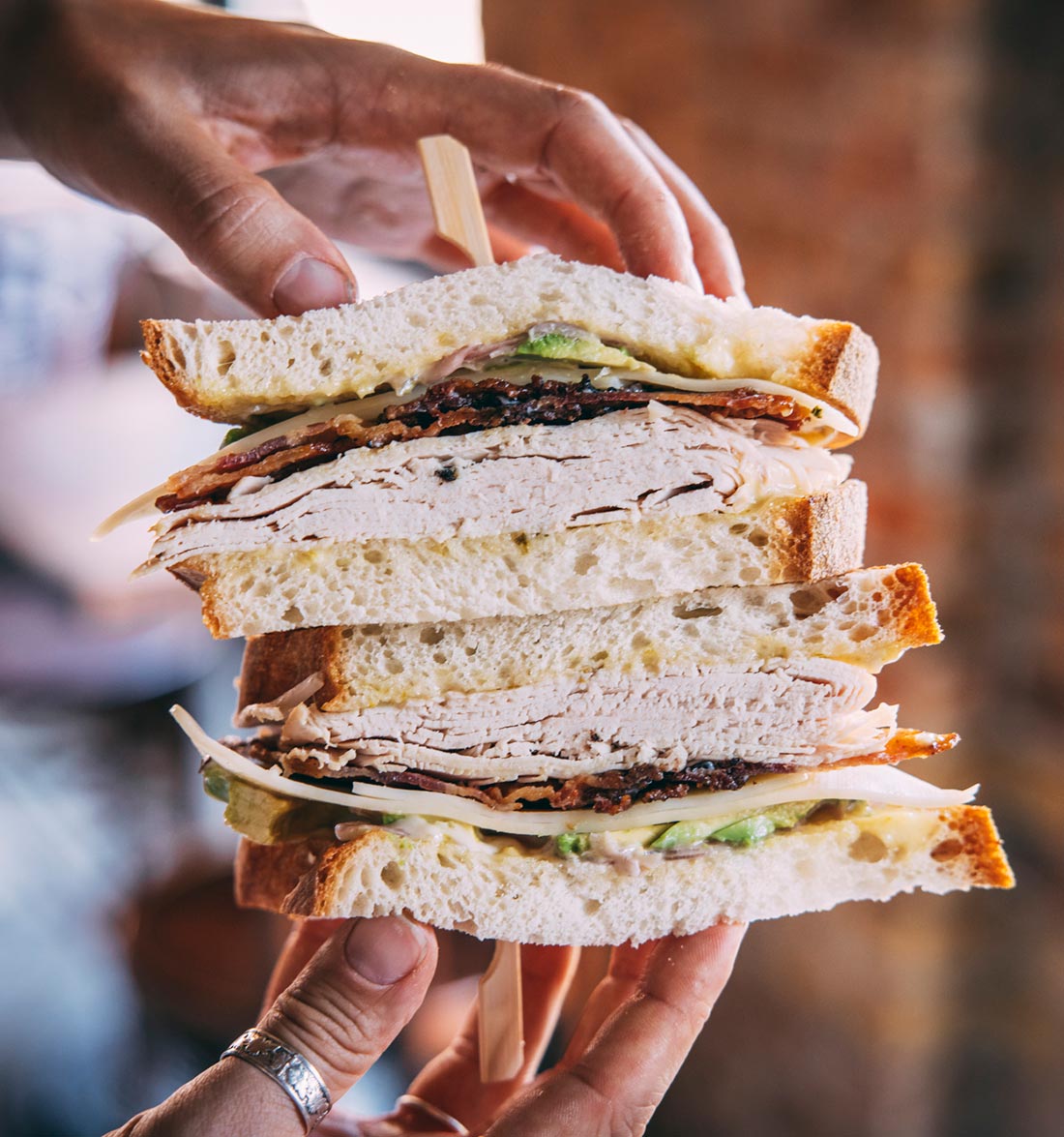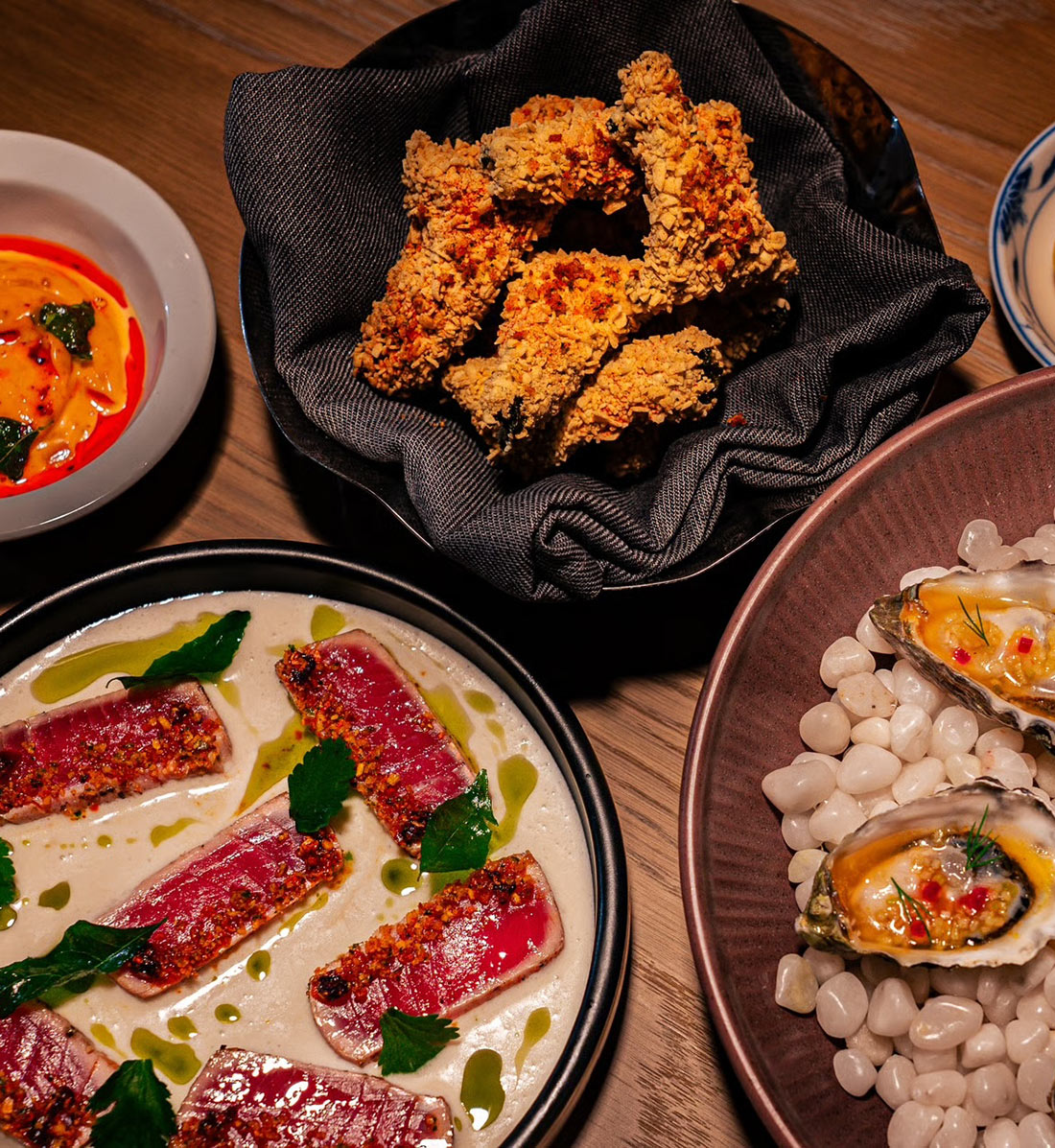The culinary world is continually evolving: from menu changes and renovations, to chefs finding new homes, it's an exciting time in the gastronomic landscape. But with so much change, it can be hard keeping track of it all. That's why we took it upon ourselves to round up the most delicious restaurants that you should have on your radar, what to order, and everything in between.
So, whether it's Michael White's (Marea, Ai Fiori) pasta and crudo heaven or Chef Melissa Rodriguez's (previously of the now-closed Two Star Al Coro) custom-designed 12-foot Mibrasa wood-fired grill, these MICHELIN Guide talents prove that the next act is just as exciting as their first.
Below, we highlight a few of the newest openings and break down the ethos behind plates.
Santi, Co-Owners Michael White and Bruce Bronster
11 E 53rd St, New York, NY 10022
The goal with Santi, according to co-owners Michael White and Bruce Bronster, is to bring beautiful Italian ingredients to New York City and showcase them with reverence and respect. “We want guests to feel like they’re stepping into an Italian home where the food and hospitality are the top priorities,” explains Bronster. “When Italians entertain, there’s a feeling that everyone is either family or a treasured guest. That’s what we want here.”
The food here is pan-Italian (think handmade pastas and crudos), and is the physical manifestation of White’s culinary career with a focus on simplicity and balance. “It’s a celebration of Italian cooking,” adds White. “I want to ensure that I’m delivering the best experience to people that spend their precious time and money at my restaurants.”

What makes Santi special?
Everything is made in house, from each individual piece of pasta to the bread (made with lievito madre), pistachio creme and beyond. We’re sourcing milk from upstate, churning it into butter and culturing it, etc.
—MW
There’s a lot of great Italian food around New York, but this restaurant is special because it’s a Michael White restaurant. This is a guy that was knighted by the Italian government with the Cavaliere dello Stato Italiano distinction for contributions to culture. I’m allowed to brag since he’s my business partner.
—BB
What is the secret ingredient to making good pasta?
Salt in the water. You could have the best quality pasta in the world but if you don’t salt the water, it’s not going to work.
—MW
What is the dish to order at Santi?
The rabbit. It’s done in multiple courses, so the experience is really sustained. It’s whole roasted saddle served with confit legs, cappelletti with carrot puree, and rabbit juices. Divine.
—MW
It sounds silly but I love the steak, it’s just so good. It’s dry-aged, prime wagyu that has been comfited with polenta on the side. Eight ounces of the most perfect steak you can imagine. Elegant and beautifully composed.
—BB
What price range can customers expect at Santi?
Dishes are $22 to $126 (which is for the rabbit for 2).
—MW
When is the best time to stop by?
Early and later tend to be great times, like 5-6:30 or after 8PM.
—MW

Crane Club, Chef Melissa Rodriguez
85 10th Ave, New York, NY 10011
“We wanted something that was more approachable but would also satisfy our diners looking for interesting dishes and ingredients,” explains Crane Club’s chef Melissa Rodriguez (previously of the now closed Two Star Al Coro and One Star Daniel). Menu highlights include baked shells, Parmigiano Reggiano-aged NY strip steak, and lamb chop—most of which are cooked with a 12-foot Mibrasa wood-fired grill custom-designed by Rodriguez. “We chose to focus on a wood burning grill because we had so much fun with it when we opened Mel's (Rodriguez’s wood-fired pizzeria). The wood gives food flavors that are otherwise unable to be produced—it can take the simplest vegetable or protein and transform it into something incredibly delicious.”
Courtesy of beverage director Chris Lemperle (One MICHELIN Star Crown Shy), those dishes are accompanied by an extensive menu of modern takes on classic cocktails, international wines, and non-alcoholic beverages. “We believe we have built something that’s both celebratory and familiar enough to pop into during the week,” Rodriguez adds. “Everything we serve is thought-out carefully: from the cocktail program, the wine list, and ingredients we source.”

Is there anything you learned from Two Star Al Coro and One Star Daniel that you’ve expanded upon with Crane Club?
I have always been very driven to do more and surround myself with people and workplaces that are challenging. I think that every project is a culmination of your previous experience. The kitchens I have had the honor of being a part of - all have strict standards of quality. That is something I have tried to carry forward here at Crane, just as in my previous kitchens. I strive to be a great leader and mentor to my cooks, and coach them as they develop their own paths.
Are there any ingredients that you're especially excited to work with?
The menu has lots of ingredients featured that may be less obvious than what the menu itself reads. Much of my team has been cooking together for quite some time. And since the culinary guidelines were much more relaxed than in previous incarnations, we have the opportunity to use ingredients that we hadn't played with before. Things like Urfa chilies, guava, shoyu, to name a few and when mixed in with techniques such as fermentation or coal roasting—we have a lot to play with!
What is the dish to order at Crane Club?
Parmigiano Reggiano-Aged NY Strip Steak and Sweet Potato. Our New York Strip Steak is dry- aged in a parmigiano reggiano crust. Once grilled, the result is a soft pink center and charred, salty, exterior. Pair this with our sweet potato topped with whipped honey, tamari butter, aleppo, scallion, and mascarpone for an ideal sweet and savory combo.
What price range can customers expect at Crane Club?
Starters begin at $17, while mains start at $29.
When is the best time to stop by?
The restaurant opens at 5PM with the last seating at 10:45PM. We recommend you come in early and finish your experience at the bar beside the dining room!

Twin Tails, Chef/Partner Craig Koketsu
10 Columbus Cir 3rd Floor, New York, NY 10019
Twin Tails was conceptualized with one goal in mind: to create a restaurant that celebrated food from the Southeast Asian region. “We want to present delicious and engaging Southeast Asian food with our unique Quality Branded (Don Angie) lens,” says Craig Koketsu, the chef/partner of Columbus Circle’s hottest new addition. “We put a lot of thought and effort into the presentation so you’re not only getting delicious food, but food that is exciting and engaging when it hits the table.”
For Koketsu, that means leaning on influences from Thai and Vietnamese cuisine for signature dishes like the banh khot (savory Vietnamese mini pancakes with peekytoe crab and champagne mango), king crab and uni buns, and Thai iced coffee affogato (vanilla bean ice cream, Thai coffee caramel, roasted peanuts). “The interesting thing is that while both Thailand and Vietnam use many of the same or similar ingredients, they are stylistically very different,” describes Koketsu. “We love how our menu combines the big, bold and spicy Thai flavors with the fresh, light and herbal flavors of Vietnam.”
Guests can also find those Southeast Asian influences in the cocktail menu (Beverage Director Bryan Schneider), with drinks like salted lychee martini (vodka, lychee, olive, and lime leaf) and the Bangkok Screwdriver (vodka, calamansi, galangal, Thai basil, and chili).
“We hope that people will try things they’ve never tried before and love them.”

Walk us through the menu, what was the starting point behind it?
The starting point came from the beauty of Southeast Asian cuisines—how they so effortlessly combine many very distinct ingredients (like toasted cumin, makrut lime leaves, chilies, tamarind, fish sauce) into one seamlessly delicious dish.
Walking into the restaurant feels like stepping into a time machine, what was the inspiration behind that?
We were inspired by New York City in the late 80s and early 90s – we worked with AvroKO, our longtime design partners, to build a room that feels a bit like Mr. Chow and the other iconic Asian restaurants of that time that were art-forward, clubby, and kind of scene-y in a fun and, at times, chaotic way. The music at Twin Tails has some 80s B-sides and new music from the current era that call back to that time, like Bleachers and Thundercat.
What is the dish to order at Twin Tails?
The Red Curry Coconut Souffle! It’s one of the sleeper hits on the menu. Understandably, it’s eclipsed by the Pistachio Pandan and Vietnamese Mocha souffles on the dessert menu (we have four flavors in total), but more people should be ordering this one nightly. The red coconut curry souffle can be easily overlooked, but the combination of the coconut souffle and red curry crème anglaise is the most unexpectedly delicious flavor combination.
What price range can customers expect at Twin Tails?
The menu is designed to be shared amongst a group and our portions are quite generous, so diners can expect around $80 per person with plenty of food to pass around the table.
When is the best time to stop by?
I love the late-night scene at Twin Tails. The lighting in the dining room is so warm and glowy and with the expansive windows, you can really watch New York City buzzing down below. Even if you just come for drinks and souffles, it’s a really great place for later in the evening on a weeknight

Leonetta, Chef Ed Cotton
181 Lexington Ave, New York, NY 10016
“We wanted to create a menu that tells a little story of where I have been and who I have worked for,” explains chef Ed Cotton (One MICHELIN Star Daniel) “The food is very identifiable and approachable. I have pulled a lot of inspiration from my nearly three decades of cooking and working in restaurants.”
Highlights include spanakopita stuffed pita bread, black truffle mafaldine, and crispy pork shank shawarma—all fresh and seasonal plates meant to be shared.
The cocktail menu riffs off classic cocktails, with signatures like the Italo Disco (murcian lemon gin, aperol, bitter bianco, oka kura yuzu liqueur, sicilian lemonade) and Kiss the Ring (blended scotch, caffo amaretto, amontillado sherry, maldon sea salt, allspice) making an appearance; while the wine list focuses on eastern and western parts of the Mediterranean.
“I’d like Leonetta be a place for the neighborhood and know that they can always get a great meal and drink,” adds Cotton. “A place to gather with friends, something that’s non pretentious and a place to feel comfortable in, surrounded by living plants, greenery and great music.”

What are some things you learned from Chef Daniel Boulud that you still use today?
I have learned a great deal along the way and some of my most memorable cooking moments were with Daniel. I learned quite a bit but something that sticks out the most the importance of respecting the true origin of traditional dishes. The history of the dish is very important and staying true to the roots of a recipe. Creating something you can dance around but still respecting the origin of the dish & its ingredients.
What do you hope to accomplish with the menu at Leonetta?
I believe and pride myself in finding great products, ingredients and unique flavors. Some of the ingredients that we are having fun with right now is sumac, black garlic, Persian limes, Baharat seasoning,
What is one thing your audience should know about Leonetta?
The audience that comes in and dines at Leonetta should understand that the food and drink has been carefully thought out. It’s a well curated menu overall, it serves a purpose and tells a story about who I am as a chef and person. It’s a journey.
What is the dish to order at Leonetta?
My current favorite is the pork shank shawarma. It’s a very impressive cut of meat—crispy, succulent and juicy. It’s served with warm pita bread, red and white sauce, house pickles, red onion and parsley salad. There is no wrong or right way to eat this. Get in there and get dirty.
What price range can customers expect at Leonetta?
Appetizers range from $12-$24, while mains range from $22-$68.
When is the best time to stop by?
We recommend visiting on Thursday, Friday or Saturday, when diners can also stop by the lower level to have a drink at our sister concept Leo's Famous.

Hero image: Evan Sung / Santi


















